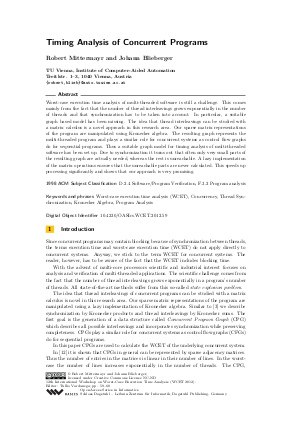Timing Analysis of Concurrent Programs
Authors Robert Mittermayr, Johann Blieberger
-
Part of:
Volume:
12th International Workshop on Worst-Case Execution Time Analysis (WCET 2012)
Part of: Series: Open Access Series in Informatics (OASIcs)
Part of: Conference: Workshop on Worst-Case Execution Time Analysis (WCET) - License:
 Creative Commons Attribution-NonCommercial-NoDerivs 3.0 Unported license
Creative Commons Attribution-NonCommercial-NoDerivs 3.0 Unported license
- Publication Date: 2012-07-10
File

PDF
OASIcs.WCET.2012.59.pdf
- Filesize: 471 kB
- 10 pages
Document Identifiers
Subject Classification
Keywords
- Worst-case execution time analysis (WCET)
- Concurrency
- Thread Synchronization
- Kronecker Algebra
- Program Analysis
Metrics
- Access Statistics
-
Total Accesses (updated on a weekly basis)
0Document
0Metadata
Abstract
Worst-case execution time analysis of multi-threaded software is still a challenge. This comes mainly from the fact that the number of thread interleavings grows exponentially in the number of threads and that synchronization has to be taken into account. In particular, a suitable graph based model has been missing. The idea that thread interleavings can be studied with a matrix calculus is a novel approach in this research area. Our sparse matrix representations of the program are manipulated using Kronecker algebra. The resulting graph represents the multi-threaded program and plays a similar role for concurrent systems as control flow graphs do for sequential programs. Thus a suitable graph model for timing analysis of multi-threaded software has been set up. Due to synchronization it turns out that often only very small parts of the resulting graph are actually needed, whereas the rest is unreachable. A lazy implementation of the matrix operations ensures that the unreachable parts are never calculated. This speeds up processing significantly and shows that our approach is very promising.
Cite As Get BibTex
Robert Mittermayr and Johann Blieberger. Timing Analysis of Concurrent Programs. In 12th International Workshop on Worst-Case Execution Time Analysis. Open Access Series in Informatics (OASIcs), Volume 23, pp. 59-68, Schloss Dagstuhl – Leibniz-Zentrum für Informatik (2012)
https://doi.org/10.4230/OASIcs.WCET.2012.59
BibTex
@InProceedings{mittermayr_et_al:OASIcs.WCET.2012.59,
author = {Mittermayr, Robert and Blieberger, Johann},
title = {{Timing Analysis of Concurrent Programs}},
booktitle = {12th International Workshop on Worst-Case Execution Time Analysis},
pages = {59--68},
series = {Open Access Series in Informatics (OASIcs)},
ISBN = {978-3-939897-41-5},
ISSN = {2190-6807},
year = {2012},
volume = {23},
editor = {Vardanega, Tullio},
publisher = {Schloss Dagstuhl -- Leibniz-Zentrum f{\"u}r Informatik},
address = {Dagstuhl, Germany},
URL = {https://drops.dagstuhl.de/entities/document/10.4230/OASIcs.WCET.2012.59},
URN = {urn:nbn:de:0030-drops-35570},
doi = {10.4230/OASIcs.WCET.2012.59},
annote = {Keywords: Worst-case execution time analysis (WCET), Concurrency, Thread Synchronization, Kronecker Algebra, Program Analysis}
}
